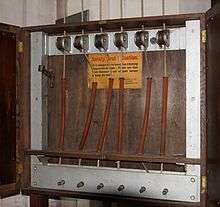Ellacombe apparatus

Ellacombe apparatus is a method for performing change ringing of church bells requiring only one person. Unlike the traditional method, where the bells are spun 360 degrees to sound them and one person is needed for each bell, instead the bells are kept static and a hammer is struck against the inside of the bell. Each hammer is connected by a rope to a fixed frame in the bell-ringing room. When in use the ropes are taut, and pulling one of the ropes towards the operator will strike the hammer against the bell. For normal, full circle, ringing the ropes are slackened to allow the hammers to drop away from the moving bells.
The system was devised by Reverend Henry Thomas Ellacombe of Gloucestershire, who first had such a system installed in Bitton in 1821. It is believed he created the system to make bell-ringers redundant, so churches did not have to tolerate the behaviour of unruly bell-ringers just so they could have their bells expertly rung.
The Ellacombe apparatus has been removed from many towers in the UK, but there are still visible holes in the ceiling which the ropes would come through into the ringing chamber, and often the frames are still in the ringing chamber, without ropes. In towers where the apparatus remains intact, it is generally used like a Carillon to play tunes.
See also
Places where you can play an Ellacombe
- Church of St Anne (Shandon)
- Bath Abbey
- St Mary's Church, Hickling, Norfolk
- Dunblane Cathedral
- St. Peter and Holy Cross Church [ Wherwell, Hampshire]
References
Trevor S Jennings (1991). The Development of British Bell Fittings.
External links
- Bell Ringing Glossary
- Campanology: Chimes (a concise chapter in the general article Campanology)